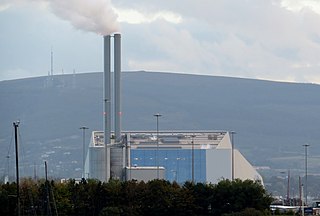Related Research Articles

Electricity generation is the process of generating electric power from sources of primary energy. For utilities in the electric power industry, it is the stage prior to its delivery to end users or its storage.
Electricity retailing is the final sale of electricity from generation to the end-use consumer. This is the fourth major step in the electricity delivery process, which also includes generation, transmission and distribution.

Electric power distribution is the final stage in the delivery of electricity. Electricity is carried from the transmission system to individual consumers. Distribution substations connect to the transmission system and lower the transmission voltage to medium voltage ranging between 2 kV and 33 kV with the use of transformers. Primary distribution lines carry this medium voltage power to distribution transformers located near the customer's premises. Distribution transformers again lower the voltage to the utilization voltage used by lighting, industrial equipment and household appliances. Often several customers are supplied from one transformer through secondary distribution lines. Commercial and residential customers are connected to the secondary distribution lines through service drops. Customers demanding a much larger amount of power may be connected directly to the primary distribution level or the subtransmission level.
In a broad sense, an electricity market is a system that facilitates the exchange of electricity-related goods and services. During more than a century of evolution of the electric power industry, the economics of the electricity markets had undergone enormous changes for reasons ranging from the technological advances on supply and demand sides to politics and ideology. A restructuring of electric power industry at the turn of the 21st century involved replacing the vertically integrated and tightly regulated "traditional" electricity market with multiple competitive markets for electricity generation, transmission, distribution, and retailing. The traditional and competitive market approaches loosely correspond to two visions of industry: the deregulation was transforming electricity from a public service into a tradable good. As of 2020s, the traditional markets are still common in some regions, including large parts of the United States and Canada.
Delivery may refer to:

The electric power industry covers the generation, transmission, distribution and sale of electric power to the general public and industry. The commodity sold is actually energy, not power, e.g. consumers pay for kilowatt-hours, power multiplied by time, which is energy. The commercial distribution of electricity started in 1882 when electricity was produced for electric lighting. In the 1880s and 1890s, growing economic and safety concerns lead to the regulation of the industry. What was once an expensive novelty limited to the most densely populated areas, reliable and economical electric power has become an essential aspect for normal operation of all elements of developed economies.

An electric vehicle (EV) is a vehicle that uses one or more electric motors for propulsion. It can be powered by a collector system, with electricity from extravehicular sources, or it can be powered autonomously by a battery. EVs include, but are not limited to, road and rail vehicles, surface and underwater vessels, electric aircraft, and electric spacecraft. For road vehicles, together with other emerging automotive technologies such as autonomous driving, connected vehicles, and shared mobility, EVs form a future mobility vision called Connected, Autonomous, Shared, and Electric (CASE) Mobility.

Cogeneration or combined heat and power (CHP) is the use of a heat engine or power station to generate electricity and useful heat at the same time.
Electrical energy is energy related to forces on electrically-charged particles and the movement of those particles. This energy is supplied by the combination of current and electric potential that is delivered by a circuit. Motion (current) is not required; for example, if there is a voltage difference in combination with charged particles, such as static electricity or a charged capacitor, the moving electrical energy is typically converted to another form of energy.

Electric power is the rate at which electrical energy is transferred by an electric circuit. The SI unit of power is the watt, one joule per second. Standard prefixes apply to watts as with other SI units: thousands, millions and billions of watts are called kilowatts, megawatts and gigawatts respectively.

In electrical engineering, a load profile is a graph of the variation in the electrical load versus time. A load profile will vary according to customer type, temperature and holiday seasons. Power producers use this information to plan how much electricity they will need to make available at any given time. Teletraffic engineering uses a similar load curve.

The Ministry of Power is an Indian government ministry. The current Union Cabinet Minister is Raj Kumar Singh. The ministry is charged with overseeing electricity production and infrastructure development, including generation, transmission, and delivery, as well as maintenance projects.
EPRI, is an American independent, nonprofit organization that conducts research and development related to the generation, delivery, and use of electricity to help address challenges in the energy industry, including reliability, efficiency, affordability, health, safety, and the environment.
A wind power forecast corresponds to an estimate of the expected production of one or more wind turbines in the near future, up to a year. Forecast are usually expressed in terms of the available power of the wind farm, occasionally in units of energy, indicating the power production potential over a time interval.

A smart grid is an electrical grid which includes a variety of operation and energy measures including:
An independent power producer (IPP) or non-utility generator (NUG) is an entity that is not a public utility but owns facilities to generate electric power for sale to utilities and end users. NUGs may be privately held facilities, corporations, cooperatives such as rural solar or wind energy producers, and non-energy industrial concerns capable of feeding excess energy into the system.

An electrical grid is an interconnected network for electricity delivery from producers to consumers. Electrical grids vary in size and can cover whole countries or continents. It consists of:

The Gujarat Urja Vikas Nigam Limited (GUVNL) is a state electricity regulation board in the Indian state of Gujarat. It is wholly owned by the Government of Gujarat. It was set up in May 1999 and is registered under the Companies Act 2013. The company was incorporated under the Gujarat Electricity Board (GEB) as wholly-owned subsidiary. The company aims towards restructuring the power sector and improving efficiency of its management and distribution of various services to consumers. As a part of the power reform process, the Electricity Act, 2003, was passed by the Government of India and Gujarat Electricity Industry Act, 2003, was passed by the Government of Gujarat to organize and administer the electricity industry with an aim to improve efficiency in management and delivery of services to consumers.

The Dublin Waste-to-Energy Facility, also known as the Poolbeg Incinerator, is a waste-to-energy plant serving the Greater Dublin Area, located on the Poolbeg peninsula. The plant is capable of producing up to 60 megawatts of electricity, enough to power 80,000 homes, and provide district heating for up to 50,000 homes in the Dublin area. The facility will process up to 600,000 tonnes of waste per year. Poolbeg accepted its first delivery of waste on the 24th of April 2017.
Starting in 2022, Moldova suffered its worst energy crisis since its independence. It is hugely influenced by the 2022 Russian invasion of Ukraine.
